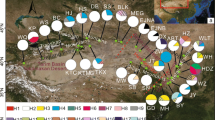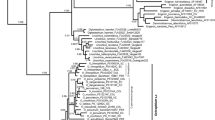Abstract
Phylogeographic patterns of Ammopiptanthus in northwestern China were examined with internal transcribed spacer (ITS) and three chloroplast intergenic spacers (trnH–psbA, trnL–trnF, and trnS–trnG). Two ITS genotypes (a–b) and 8 chloroplast haplotypes (A–H) were detected. Both ITS genotypes and chloroplast lineages were split in two geographic regions: western Xinjiang and the Alxa Desert. This lineage split was also supported by AMOVA analysis and the Mantel test. AMOVA showed that 89.81 % of variance in Ammopiptanthus occurred between the two geographic regions, and correlation between genetic distances and geographical distances was significant (r = 0.757, p < 0.0001). All populations in western Xinjiang shared haplotype A with high frequency, and range expansion was strongly supported by negative Fu’s FS value, and mismatch distribution analysis, whereas populations in the Alxa Desert had higher genetic diversity and structure. We speculate that the cold and dry climate during the early Quaternary fragmented habitats of the species, limiting gene flow between regions, and interglacial periods most likely led to the range expansion in western Xinjiang. The low genetic diversity of Ammopiptanthus indicate a significant extinction risk, and protective measures should be taken immediately.





Similar content being viewed by others
References
Aris-Brosou S, Excoffier L (1996) The impact of population expansion and mutation rate heterogeneity on DNA sequence polymorphism. Mol Biol Evol 13:494–504
Avise JC (2000) Phylogeography: the history and formation of species. Harvard University Press, Cambridge
Birky CW Jr (2001) The inheritance of genes in mitochondrial and chloroplast: laws, mechanisms, and models. Annu Rev Genet 35:125–148
Bohonak AJ (2002) IBD (isolation by distance): a program for analyses of isolation by distance. J Hered 93:153–154
Browning TL, Taggart DA, Rummery C, Close RL, Eldridge MDB (2001) Multifaceted genetic analysis of the ‘‘Critically Endangered’’ brush-tailed rock-wallaby Petrogale penicillata in Victoria, Australia: implications for management. Conserv Genet 2:145–156
Burdon JJ, Jarosz AM, Brown AHD (1988) Temporal patterns of reproduction and outcrossing in weedy populations of Echium plantagium. Biol J Linn Soc 34:81–92
Chen GQ, Crawford D, Huang HW, Ge XJ (2009a) Genetic structure and mating system of Ammopiptanthus mongolicus (Leguminosae), an endangered shrub in north-western China. Plant Species Biol 24:179–188
Chen GQ, Huang HW, Crawford DJ, Pan BR, Ge XJ (2009b) Mating system and genetic diversity of a rare desert legume Ammopiptanthus nanus (Leguminosae). J Syst Evol 47(1):57–66
Clement M, Posada D, Crandall KA (2000) TCS: a computer program to estimate gene genealogies. Mol Ecol 9:1657–1659
Comes HP, Kadereit JW (1998) The effect of quaternary climatic changes on plant distribution and evolution. Trends Plant Sci 3:432–438
Crandall KA, Bininda-Emonds ORP, Mace GM, Wayne RK (2000) Considering evolutionary processes in conservation biology. Trends Ecol Evol 15:290–295
Cui HB (1998) Fabaceae (5). In: Wu ZY, Raven PH (eds) Flora of China, vol 42. Science Press, Beijing, pp 395–397
Dang RL, Pan XL, Gu XF (2002) Floristic analysis of spermatophyte genera in the arid deserts area in North-West China. Guihaia 22(2):121–128
Doyle JJ, Doyle JL (1987) A rapid DNA isolation procedure from small quantities of fresh leaf tissues. Phytochem Bull 19:11–15
Drummond AJ, Rambaut A (2007) BEAST: bayesian evolutionary analysis by sampling trees. BMC Evol Biol 7:214
Drummond AJ, Nicholls GK, Rodrigo AG, Solomon W (2002) Estimating mutation parameters, population history and genealogy simultaneously from temporally spaced sequence data. Genetics 161:1307–1320
Dupanloup I, Schneider S, Excoffier L (2002) A simulated annealing approach to define the genetic structure of populations. Mol Ecol 11:2571–2581
Excoffier L, Smouse P, Quattro J (1992) Analysis of molecular variance inferred from metric distances among DNA haplotypes: applications to human mitochondrial DNA restriction data. Genetics 131:479–491
Excoffier L, Laval G, Schneider S (2005) Arlequin (version 3.0): an integrated software package for population genetics data analysis. Evol Bioinform 1:47–50
Frankel OH (1983) The place of management in conservation. In: Schonewald-Cox CM, Chambers SM, MacBryde B, Thomas WL (eds) Genetics and conservation. Benjamin-Cummings, Menlo Park
Frankham R, Ballou JD, Briscoe DA (2002) Introduction to conservation genetics. Cambridge University Press, Cambridge
Fraser DJ, Bernatchez L (2001) Adaptive evolutionary conservation: towards a unified concept for defining conservation units. Mol Ecol 10:2741–2752
Fu LG (1992) Rare and endangered plants in China. Science Press, Beijing, pp 368–370
Fu YX (1997) Statistical tests of neutrality of mutations against population growth, hitchhiking, and background selection. Genetics 147:915–925
Ge XJ, Yu Y, Yuan YM, Huang HW, Yan C (2005) Genetic diversity and geographic differentiation in endangered Ammopiptanthus (Leguminosae) populations in desert regions of northwest China as revealed by ISSR analysis. Ann Bot (London) 95:843–851
Gitzendanner MA, Soltis PS (2000) Patterns of genetic variation in rare and widespread plant congeners. Am J Bot 87:783–792
Guo ZT, Peng SZ, Hao QZ, Chen XH, Liu TS (1999) Late Tertiary development of aridification in northwestern China: link with the arctic ice-sheet formation and Tibetan uplifts. Quat Sci 6:556–566 (in Chinese with English abstract)
Guo YP, Zhang R, Chen CY, Zhou DW, Liu JQ (2010) Allopatric divergence and regional range expansion of Juniperus sabina in China. J Syst Evol 48:153–160
Hewitt GM (2000) The genetic legacy of the Quaternary ice ages. Nature 405:907–913
Hewitt GM (2004) Genetic consequences of climatic oscillations in the Quaternary. Phil Trans R Soc Lond B Biol Sci 359:183–195
Jia DR, Liu TL, Wang LY, Zhou DW, Liu JQ (2011) Evolutionary history of an alpine shrub Hippophae tibetana (Elaeagnaceae): allopatric divergence and regional expansion. Biol J Linn Soc 102:37–50
Jia DR, Abbott RJ, Liu TL, Mao KS, Bartish IV, Liu JQ (2012) Out of the QinghaieTibet Plateau: evidence for the origin and dispersal of Eurasian temperate plants from a phylogeographic study of Hippophaë rhamnoides (Elaeagnaceae). New Phytol 194:1123–1133
Lande R (1998) Anthropogenic, ecological and genetic factors in extinction and conservation. Res Popul Ecol 40:259–269
Li ZH, Chen J, Zhao GF, Guo YP, Kou YX, Ma YZ, Wang G, Ma XF (2012) Response of a desert shrub to past geological and climatic change: a phylogeographic study of Reaumuria soongarica (Tamaricaceae) in western China. J Syst Evol 50:351–361
Liu YX (1995) A study on origin and formation of the Chinese desert floras. Acta Phytotaxon Sin 33:131–143
Liu JQ, Sun YS, Ge XJ, Gao LM, Qiu YX (2012) Phylogeographic studies of plants in China: advances in the past and directions in the future. J Syst Evol 50:267–275
Mäder G, Zamberlan PM, Fagundes NJR, Magnus T, Salzano FM, Bonatto SL, Freitas LB (2010) The use and limits of ITS data in the analysis of intraspecific variation in Passiflora L. (Passifloraceae). Genet Mol Biol 33:99–108
Martins K, Chaves L, Vencovsky R, Kageyama P (2011) Genetic structure based on nuclear and chloroplast microsatellite loci of Solanum lycocarpum A. St. Hil. (Solanaceae) in Central Brazil. Genet Mol Res 10:665–677
Moritz C (1994) Applications of mitochondrial DNA analysis in conservation: a critical review. Mol Ecol 3:401–411
Osborne MJ, Norman JA, Christidis L, Murray ND (2000) Genetic distinctness of isolated populations of an endangered marsupial, the mountain pygmy-possum, Burramys parvus. Mol Ecol 9:609–613
Qin AL, Wang MM, Cun YZ, Yang FS, Wang SS, Ran JH, Wang XQ (2013) Phylogeographic evidence for a link of species divergence of Ephedra in the Qinghai-Tibetan Plateau and adjacent regions to the Miocene Asian Aridification. PLoS One 8(2):e56243
Rogers SO, Bendich AJ (1985) Extraction of DNA from milligram amounts of fresh, herbarium and mummified plant-tissues. Plant Mol Biol Rep 5:69–76
Rogers A, Harpending H (1992) Population growth makes waves in the distribution of pairwise genetic differences. Mol Biol Evol 9:552–569
Rosenberg MS (2001) PASSAGE: Pattern Analysis, Spatial Statistics and Geographic Exegesis. Ver. 1.1. Department of Biology: Arizona State University
Ryder OA (1986) Species conservation and systematics: the dilemma of subspecies. Trends Ecol Evol 1:9–10
Sang T, Crawford DJ, Stuessy TF (1997) Chloroplast DNA phylogeny, reticulate evolution, and biogeography of Paeonia (Paeoniaceae). Am J Bot 84:1120–1136
Shaw J, Lickey E, Beck JT, Farmer SB, Liu W, Miller J, Siripun KC, Winder CT, Schilling EE, Small RL (2005) The tortoise and the hare II: relative utility of 21 noncoding chloroplast DNA sequences for phylogenetic analysis. Am J Bot 92:142–166
Shi YF, Cui ZJ, Su Z (2005) The quaternary glaciations and environmental variations in China. Hebei Science and Technology Publishing House, Hebei, China, pp 85–100
Slatkin M, Hudson RR (1991) Pairwise comparisons of mitochondrial DNA sequences in stable and exponentially growing populations. Genetics 129:555–562
Su ZH, Zhang ML (2013) Evolutionary response to Quaternary climate aridification and oscillations in northwestern China revealed by chloroplast phylogeography of Nitraria sphaerocarpa (Nitrariaceae). Biol J Linn Soc 109:757–770
Su ZH, Zhang ML, Sanderson SC (2011) Chloroplast phylogeography of Helianthemum songaricum (Cistaceae) from northwestern China: implications for preservation of genetic diversity. Conserv Genet 12:1525–1537
Sun H (2002) Tethys retreat and Himalayas-Hengduanshan Mountains uplift and their significance on the origin and development of the Sino-Himalayan elements and alpine flora. Acta Bot Yunnanica 24:273–288
Sun H, Li ZM (2003) Qinghai-Tibet plateau uplift and its impact on Tethys flora. Adv Earth Sci 18:852–862
Swofford DL (2002) PAUP*: phylogenetic analysis using parsimony (and other methods), Version 4.0b10. Sinauer Associates, Sunderland, MA
Taberlet PL, Pautou GG, Bouvet J (1991) Universal primers for amplification of three non-coding regions of chloroplast DNA. Plant Mol Biol 17:1105–1109
Tajima F (1989) Statistical method for testing the neutral mutation hypothesis by DNA polymorphism. Genetics 123:585–595
Tajima F (1996) The amount of DNA polymorphism maintained in a finite population when the neutral mutation rate varies among sites. Genetics 143:1457–1465
Tang YC (2000) On the affinities and the role of the Chinese flora. Acta Bot Yunnanica 22:1–26
Templeton AR, Crandall KA, Sing CF (1992) A cladistic analysis of phenotypic associations with haplotypes inferred from restriction endonuclease mapping and DNA sequence data. III. Cladogram estimation. Genetics 132:619–633
Thompson JD, Higgins DG, Gibson TJ (1994) Clustal-W—improving the sensitivity of progressive multiple sequence alignment through sequence weighting, position-specific gap penalties and weight matrix choice. Nucleic Acids Res 22:4673–4680
Wang HC, Sun H, Compton JA, Yang JB (2006) A phylogeny of Thermopsideae (Leguminosae: Papilionoideae) inferred from nuclear ribosomal internal transcribed spacer (ITS) sequences. Biol J Linn Soc 151:365–373
Wang LY, Abbott RJ, Zhang W, Chen P, Wang YJ, Liu JQ (2009) History and evolution of alpine plants endemic to the Qinghai-Tibetan Plateau: Aconitum gymnandrum (Ranunculaceae). Mol Ecol 18:709–721
Wei Z, Lock JM (2010) Fabaceae Tribe Thermopsideae. In: Wu ZY, Raven PH (eds) Flora of China, vol 10. Science Press, Beijing, p 100
White TJ, Bruns T, Lee S, Taylor JW (1990) Amplification and direct sequencing of fungal ribosomal RNA genes for phylogenetics. In: Innis MA, Gelfand DH, Sninsky JJ, White TJ (eds) PCR protocols: a guide to methods and applications. Academic Press, San Diego, pp 315–322
Wiley EO (1978) The evolutionary species concept reconsidered. Syst Biol 27:17–26
Williams MAJ, Dunkerley DL, De Dekker P, Kershaw AP, Stokes T (1993) Quaternary environments. Edward Arnold, London
Wolfe KH, Li WH, Sharp PM (1987) Rates of nucleotide substitution vary greatly among plant mitochondrial, chloroplast, and nuclear DNAS. Proc Natl Acad Sci USA 84:9054–9058
Wolff K, Frisco B, van Damme JMM (1988) Outcrossing rates and male sterility in natural populations of Plantago coronopus. Theor Appl Genet 76:190–196
Xie L, Yang Y (2012) Miocene origin of the characteristic broad-leaved evergreen shrub Ammopiptanthus (Leguminosae) in the desert flora of eastern central Asia. Int J Plant Sci 173(8):944–955
Xu X, Kleidon A, Miller L, Wang SQ, Wang LQ, Dong GC (2010) Late Quaternary glaciation in the Tianshan and implications for palaeoclimatic change: a review. Boreas 39:215–232
Acknowledgments
This research was supported by the National Natural Science Foundation of China (No. 41271070) and Xinjiang Institute of Ecology and Geography, Chinese Academy of Sciences. We thank professor Rui Cao and professor Yizhi Zhao at college of life science in Inner Mongolia University for their kind help in sampling work in Inner Mongolia.
Author information
Authors and Affiliations
Corresponding author
Rights and permissions
About this article
Cite this article
Su, Z., Pan, B., Zhang, M. et al. Conservation genetics and geographic patterns of genetic variation of endangered shrub Ammopiptanthus (Fabaceae) in northwestern China. Conserv Genet 17, 485–496 (2016). https://doi.org/10.1007/s10592-015-0798-x
Received:
Accepted:
Published:
Issue Date:
DOI: https://doi.org/10.1007/s10592-015-0798-x




